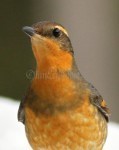
Varied Thrush in Ozaukee County WI. Photographs taken on March 3, 2013.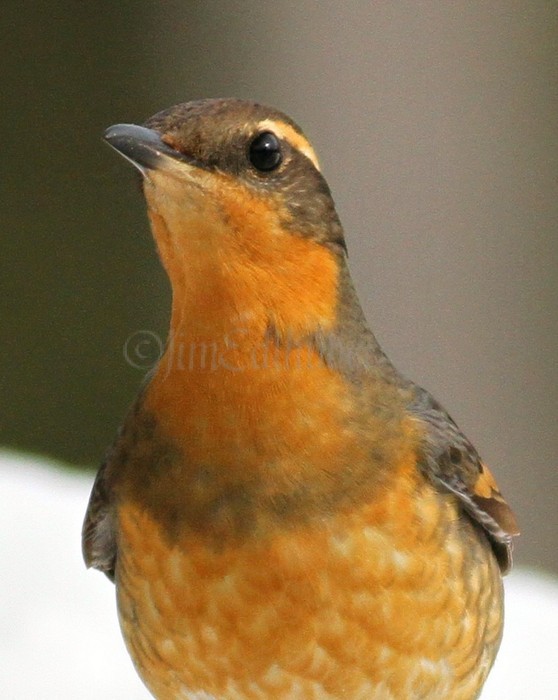
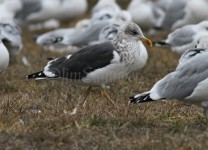
A hot spot for gulling in the cold winter months of the year is the dump and Kohl’s parking lot in Johnson Creek Wisconsin. It can provide nice views of some winter wandering gulls. Today one of the gulls present was a Lesser Black-backed Gull. Images were taken on December 18, 2012.
Binomial name: Laris fuscus
Category: Gulls, Terns, and Skimmers
Size: 21” long, 54” wing span
Weight: 1.8 lb
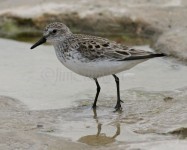
Binomial name: Calidris alba
Category: Sandpipers, Phalaropes, and Allies
Description: Whitish-gray feathers with a thick, black bill and feet.
Size: 7.1″ – 7.9″ long, 13.8″ wingspan
Weight: 1.4 oz. – 3.5 oz.
Habitat: Rocky shorelines in coastal and island regions or inland marshes and wetlands.
Diet: Insects, crustaceans, invertebrates, and plants or grasses.
Nesting: The female gathers materials and builds the nest, usually a scrape on a shallow rocky area or a preexisting depression in sand. She may line it sparsely with grasses, leaves, lichens, moss. The typical clutch size is 3 to 4 eggs and both parents incubate. The male is highly territorial and will defend the nesting site.
Notes: Sanderlings are a populous and widespread shorebird with a global distribution. They show up on nearly every temperate and tropical shoreline in the world. However, they only breed in the high Arctic.
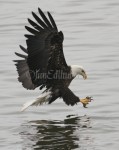
Bald Eagles on the Mississippi River in Le Claire IA in February 2012.
Binomial name: Haliaeetus leucocephalus
Category: Hawks, Kites, Eagles, and Allies
Description: Brown with a white head and white tail feathers. Yellow eyes, beak, and feet.
Size: 28″ – 40″ long, 5.9′ – 7.5′ wingspan
Weight: 6.6 lbs. – 14 lbs.
Habitat: Forested areas near open bodies of water such as lakes, rivers, wetlands, and coastal shorelines.
Diet: Mostly fish but occasionally small mammals, ducks, and gulls.
Nesting: Both parents gather materials although the female does most of the building. The nests are made out of branches and sticks and then lined with grass, moss, and feathers. They may be rebuilt and reused repeatedly over many years. The typical clutch size is 1 to 3 eggs. Both parents will incubate the eggs with the female incubating more often while the male hunts for food. The young will fledge as early as 8 weeks after hatching, or up to 14 weeks.
Notes: Bald eagles mate for life (if one partner dies, the remaining will choose a new mate). They engage in elaborate courtship rituals which involves a locking of talons followed by a free fall; they separate just before hitting the ground. The Bald Eagle is the national bird and national animal of the United States of America, appearing on many official seals of the government.
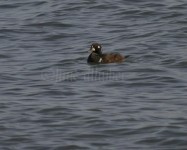
Harlequin Duck, nonbreeding male photographed at North Point in Milwaukee, Wisconsin on January 5, 2012.
Binomial name: Histrionicus histrionicus
Category: Ducks, Geese, and Swans
Description: Slate blue (male) or grayish brown (female) body with white spots or streaks on head, back, and wings. Male also has rust-colored patches on sides.
Size: 13″ – 21.3″ long, 22″ – 26″wingspan
Weight: 17.6 oz. – 25.6 oz.
Habitat: Rocky shores and coastlines in mountains or forests.
Diet: Small insects, spiders, fish, and crustaceans.
Nesting: The female provides all parental care, building a nest in a protected space on the ground, often near water. The female will lay 3 – 9 eggs at a time, laying eggs once per summer. Although the male does not help rear the young, the pair will likely mate for life.
Notes: Harlequin ducks are extremely buoyant due to their tightly packed feathers. These feathers also insulate them from chilly water while they swim and dive.
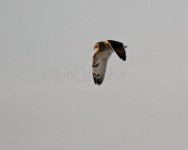
The Short-eared Owl has been one species on my list to see and photograph. The Scuppernong River Habitat Area in Waukesha County has some and I went out, spent the afternoon till dark to try to capture these cool birds. Late in the day as the sun is just starting to go down 4 birds appeared from out of no where it seemed. They hovered over the prairie areas and on occasion perched for a couple of minutes. These images are a little rough because of the little light that is left in the day when they come out and start their hunting, but show some of the action that took place. Images where taken on March 8, 2013.
Binomial name: Asio flammeus
Category: Typical Owls
Size: 15” long, 38” wing span
Weight: 12 oz
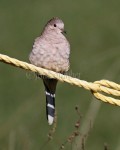
An Inca Dove was found at Concordia University in Mequon Wisconsin. This bird was actually found by a instructor of ornithology at the campus taking one of his classes out for a morning bird walk. This bird hung around for awhile and was viewed by many birders state wide as being so rare for the state. The normal range for this bird is Texas, southern New Mexico and Arizona and Mexico. Images were taken on November 1, 2011.
Binomial name: Columbina inca
Category: Pigeons and Doves
Size: 8.25” long, 11” wing span
Weight: 1.6 oz
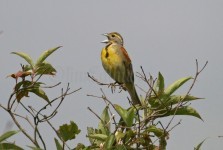
At least a couple of nesting pairs of Dickcissels were present in the Scuppernong Prairie area in Waukesha County Wisconsin. When I was there I watched adults bringing food to the young in the nests. The nests were in short growing brush vegetation in the open prairies. Images were taken on August 6, 2011.
Binomial name: Spiza americana
Category: Cardinals, Piranga Tanagers and Allies
Size: 6.25” long, 9.75” wing span
Weight: 0.95 oz
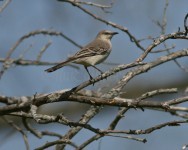
While enjoying the spring warbler migration at Lake Park a Northern Mockingbird had been spotted on the golf course. Images were taken on May 15, 2013.
Binomial name: Mimus polglottos
Category: Mockingbirds and Thrashers
Size: 10” long, 14” wing span
Weight: 1.7 oz
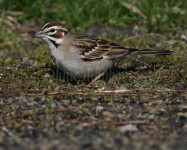
A Lark Sparrow was found by a local birder on the oval running track at Lake Park in Milwaukee Wisconsin. It is a place I check often now as birds obviously stop at this location. The Lark Sparrow not common at all here is found on rare occasions during spring migration. This bird appeared to be feeding on weed seed on the track. This was a life bird for many birders that day that were present. If my memory is correct, Paul Sparks found this bird. Images were taken on April 27, 2013.
Binomial name: Chondestes grammacus
Category: Emberizids
Size: 6.5″ long, 11” wingspan
Weight: 1 oz
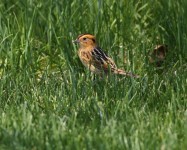
This Nelson’s Sharp-tailed Sparrow was found by local birders during spring migration at Lake Park. The exact location of this bird was at the east end of the “Magic Hedge”. The Magic Hedge is a line of deciduous trees running perpendicular with Lake Michigan just south of the Milwaukee Water Filtration Plant. It hung around for most of the day and was a life bird for many. Images were taken on May 18, 2013.
Nelson’s Sharp-tailed Sparrow
Binomial name: Ammodramus nelsoni
Category: Sparrows
Size: 5″ long, 7” wingspan
Weight: 0.6 oz
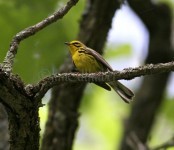
The uncommon sightings of Prairie Warblers here in Wisconsin. The location of one was found as has been reported in the South Kettle Moraine State Forest in Waukesha County on July 10, 2010. The other Prairie Warbler was only viewed by me as I birded Lake Park on September 5, 2010.
Binomial name: Dendroica discolor
Category: Warblers
Size: 4.75″ long, 7” wingspan
Weight: .27 oz
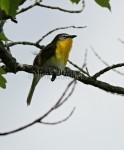
The report of Yellow-breasted Chats in the South Kettle Moraine in Waukesha County drew my attention both times. Not a common bird for this area, some years there are reports, others not. I headed out and with some other birders at the reported location reported off of Wilton Road, the bird was found in minutes, this date was May 16, 2012. The other Yellow-breasted Chat was reported off of Hwy 59. That location I birded for about 15 minutes before I locating the bird by its call, this date was May 30, 2013.
Binomial name: Icteria virens
Category: Wood-Warblers
Size: 7.5″ long, 9.75” wingspan
Weight: 0.88 oz
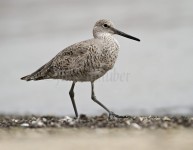
A flock of 37 American Avocets had spent the day at McKinley Beach in Milwaukee Wisconsin on May 1, 2012. Within the flock was one lone Willet that just mixed right in with the Avocets as they feed and rested for the day.
Binomial name: Tringa semipalmata
Category: Sandpipers, Phalaropes, and Allies
Size: 15” long, 26” wing span
Weight: 8 oz